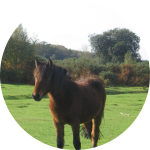|
Horse Stall contains all types of information for Horse Lovers.
There are a number of products branded horse gifts and products.
All gifts have a unique horse design that horse lovers and pony
owners will appreciate. Branded items include: t-shirts, sweatshirts,
sneakers, posters, skateboards, mouse pads, stickers, bumper stickers,
buttons, mugs, tote bags, invitations, greeting cards, neckties,
postcards, posters, prints and much more!
Horse Articles :: Fitting a Horses Saddle
Ten Top Tips on Saddle Fitting
|
|
1. Wither Clearance -The gullet of a saddle must clear
the withers but not be so narrow as to pinch the horses back.
The ideal clearance needs to be 2-3 fingers between the saddle
pommel (gullet) and horses withers. Anything less is risky
and if no clearance the saddle must not be used.
2.To check you can look down the gullet and see light
at the other end, place the saddle on the horse, girthed up,
but with no numnahs or pads and then look to see if you have
this clearance.
3. The Gullet Width - The gullet width (when seen from
underneath the saddle), should be about three inches in width
all the way down the pommel to the cantle.
4. Saddle Balance - The saddle needs to sit straight,
i.e. not dipping down at the front or back. To check this,
once you have put the saddle on the horse, look and see if
where the rider sits the saddle is sitting horizontally.
The saddle balance needs to be checked again by a person on
the ground with the rider on the horse and the horse standing
on level ground.
5. Saddle Seat Position - The seat of the saddle must
be positioned so that the rider is placed over the horse's
center of balance.
The location of the horse's center of balance depends on a
combination of speed and collection of the horse. If the horse
is standing or just walking the center of balance is just
behind the heart girth and below the withers.
If the horse is trotting or cantering, the center of balance
moves forward & if galloping or jumping the center of balance
moves even more forward. If the horse is highly collected
the center of balance will be further back regardless of gait,
than if the horse is in an extended frame.
6. The Length of Saddle - A saddle should not go beyond
the 18th thoracic vertebra, which attaches to the horses last
rib, beyond this is the lumbar spine, which is the weakest
part of the horses back. If you feel the ribs on your horse
and work your hand backwards, until you can feel their last
rib, then run your fingers up this rib till you reach the
spine - that is the point where the saddle must not go beyond.
7. The Panels -These need to be smooth and make even contact
along the horses spine so distributing the weight of the rider
evenly. An uneven fit increases pressure points and soreness.
With used saddles when you are saddle fitting you need to
check that the panels are still in good condition and don't
need re-flocking etc.
8. Movement of Saddle - When riding, the saddle should
not move backwards or forwards or rock up and down. To help
see if this is happening when saddle fitting, it helps if
you have someone standing on the ground, watching to see if
the saddle moves while you walk, trot and canter past them.
9. Tree Size - The tree size, which dictates the width
of the saddle and height of the gullet is one of the most
important factors when fitting saddles.
A tree that is too narrow, is more of a problem than one too
wide, as it will push the points of the saddle tree into the
horses back and eventually cause muscle wastage/atrophy, which
long term will result in a hollowing in the horses back either
side of the spine around the shoulder area.
It can be tested easily by looking at the sweat pattern on
the horses back after work. The sweat pattern should have
even sweating along the panels, except for the points of the
tree points, which will cause round dry spots in the area
of sweat.
10. Saddle Placement - When saddle fitting a saddle
should be placed two to four fingers behind the end of the
horse's shoulder blade.
About Author
Sarah Bell is passionate about happy healthy horses that are
kept and looked after, with their health and well being as
a main priority.
|
|
|


